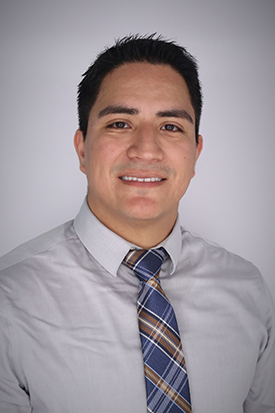Purdue HHS graduate program serves as catalyst for success in cancer-focused residency programs

Photo credit: Oluwaseyi Oderinde
Written By: Rebecca Hoffa, rhoffa@purdue.edu
Whether they’re making a difference in radiation treatments for cancer patients or ensuring safe and effective diagnostic equipment, medical physicists are a critical component of the health care field, ensuring patients receive the care they need.
From the top cancer centers in the nation to Ivy League institutions to top technology companies, graduates of the Purdue University School of Health Sciences’ CAMPEP-accredited medical physics program often achieve prestigious residency matches and successful careers that propel them toward success.
“Going to Purdue connected all the dots into why I was doing what I was doing,” said Humberto Monsivais, Purdue medical physics PhD graduate and resident at the University of Texas’ MD Anderson Cancer Center, which is consistently ranked as the United States’ top cancer hospital. “The didactic curriculum was really strong, and the research was really unique.”

Humberto Monsivais, Purdue medical physics PhD graduate
Achieving top-tier experiences
One of the most common routes for medical physics graduates, particularly those with a PhD, is to pursue a residency in an academic hospital or health care facility. These programs allow them to gain clinical and sometimes even research experience using real-world applications under expert supervision.
“If I’m going to be doing tests in the clinic that directly affect patient safety, I need to be trained, so the residency is letting me get that clinical experience while having a vast safety net,” said Philip Durham, 2024 Purdue medical physics master’s program graduate and resident at Willis Knighton Cancer Center in Shreveport, Louisiana.
In spring 2024, Purdue medical physics students saw premier residency matches, a process which involves an intensive application period and interviews prior to earning a placement. The students were placed in some of the country’s leading medical physics clinical facilities, achieving two residency placements at MD Anderson as well as placements at the Yale School of Medicine, Rutgers Cancer Institute and the Willis Knighton Cancer Center.
For Mahsa Servati, a Purdue medical physics PhD graduate and resident at MD Anderson, Purdue helped her reach the opportunity of her dreams.
“I’ve been wanting to come to MD Anderson since I was a teenager,” Servati said. “I really cared about doing something about cancer because of the history in my family. This is the best cancer center in the world, and I wanted to be part of it. It just so happened it has a residency for my dream job.”

Philip Durham, Purdue medical physics master’s program graduate
Servati went on to note the Purdue name often resonated with many of her prospective residency matches, showing how the program stands out among the 63 CAMPEP-accredited programs around the world.
“Going through the residency match, I got very good feedback of Purdue University and Purdue graduates,” Servati said. “The name itself did a lot. The people who go to Purdue are generally more ambitious, forward-moving and want big things. Being in that type of environment is encouraging and keeps you focused on what you want.”
Learning hands-on
Beyond the medical physics program’s academic rigor, the recent class of graduates also developed the Medical Physics Club of Purdue, a student organization that offers opportunities for medical physics students to interact with each other while also connecting the graduate program with the undergraduate radiological health sciences major.
“We realized our medical physics club at Purdue is unique and that we can make a signature,” Servati said. “We submitted to become an official club at Purdue, and we started doing a lot more. We did a journal club; invited alums to campus; had some board exam practice and tests; and did hospital tours to give a real view of what medical physicists do, both on the therapy side and in the diagnostic part.”
Getting involved in research is also a cornerstone of the program, Monsivais noted. With resources such as the Purdue Life Science MRI Facility and high-caliber faculty mentors, Monsivais often found his work fulfilling and supported as he developed critical research skills.

Mahsa Servati, Purdue medical physics PhD graduate
“I never felt like I didn’t have support from the faculty for whatever I wanted to do,” Monsivais said. “My advisor opened doors for me and let me figure out my own questions. That was a very big deal.”
Gaining recognition
The program, which got its start in the early 1990s, has developed throughout the years, building relationships with medical centers, strengthening the imaging and radiotherapy emphases and improving research opportunities through strategic faculty growth. This has set Purdue’s program apart from other more clinically focused programs.
“Purdue is a great place to see medical physics as an academic pursuit,” said Keith Stantz, associate professor of health sciences and former medical physics program director. “We have a focus on research and innovative ideas and trying to translate those to patient care. Purdue is a step ahead in research — I’m happy with our impact in the field.”
As Ulrike Dydak, professor of health sciences, prepares to take over as medical physics program director, she has plans for its bright future, hoping to continue the momentum from the last three decades. “I would really love for the program to continue to grow in terms of our national recognition,” Dydak said.
“Our program is giving students a lot of resources in terms of hands-on experience, particularly in imaging but also on the therapy side. I think this is a strength that residencies are looking into right now as imaging becomes more and more an important component, even on the therapy side of medical physics.”
Discover more from News | College of Health and Human Sciences
Subscribe to get the latest posts sent to your email.